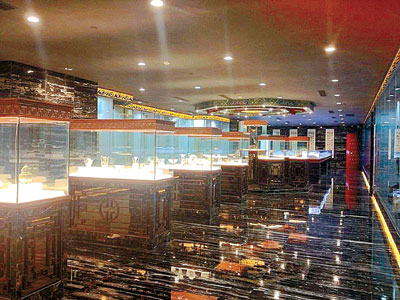
AFTER opening two venues in Nanshan and Futian districts, the city’s largest private museum, Zhizheng Art Museum, has expanded into Luohu District.
The new venue, located in Kingkey 100, was officially opened to the public Tuesday.
The Luohu venue is resplendent in architecture with a giant duplicate of Rubens’ “Rape of the Daughters of Leucippus” painted on the roof and a golden Buddha statue sitting underneath.
“The combination of Chinese and Western art represents the unique style of the Luohu venue. Zhizheng Art Museums are famous for their collections of ancient Chinese paintings and calligraphies. The museum in Luohu will be the first to also include Western-style oil paintings,” said Wu Fuqing, president of the museum.
Covering nearly 3,000 square meters, the venue has two sections, Western art and Chinese art, but the museum predominantly features Chinese artworks. The exhibition areas contain contemporary paintings and calligraphies, ancient paintings and calligraphies, porcelains, bronzes, Buddha statues and other exhibits.
Among the many highlights are about 100 ancient paintings from the Song (960-1279) to Qing (1644-1911) dynasties. Some of the works are family treasures passed down from earlier generations of his family, while others were collected by himself from places around the world, Wu said.
In the Western art area there are some oil paintings by Western artists alongside Chinese painters inspired by the style, such as the well-known painters Xu Beihong and Pan Yuliang. The artists had outstanding skills in traditional Chinese painting, but were strongly influenced by Western-style oil paintings after they went to study abroad.
“Displaying their works together with traditional Chinese paintings and calligraphies showcases the inheritance of Chinese art,” Wu said.
Since it was founded in Shenzhen in 2011, each venue of Zhizheng Art Museum receives around 100 visitors each day. As part of its outreach program the museum attends the annual China (Shenzhen) International Cultural Industries Fair (ICIF) and holds art lectures and verification activities on a regular basis. Zhizheng Art Museum has become a well-known cultural and art brand in the city.
“We call our museum ‘Zhizheng’ because it is the strongest period of the Yuan Dynasty (1279-1368), and the essence of our collections. Also, ‘Zhizheng’ means ‘the best’ in Cantonese and we hope that we can bring more positive influence to society through our efforts,” Wu said.
The museum administration is a strong supporter of academic research. A batch of top domestic and international experts are advisors to the museum. Among them, there is a former palace department director with the Palace Museum Shan Guoqiang, a painting and calligraphy department head with the Shanghai Museum Shan Guolin and a porcelain expert with the Palace Museum Ye Peilan.
Over the past two years, the museum has built an environment for Shenzhen art lovers to share, learn and exchange.
“The research work is an important part of the museum. It allows for the study of collections in the museum and objects from other organizations and individuals. It also helps promote more training and exchange activities to society,” Wu said. “Unlike cities such as Beijing and Shanghai, Shenzhen is a relatively young city in the collection market and does not have an education program yet. We hope to do something to improve the situation.”
The museum’s next target is to enter the art market.
At present, it is negotiating with several banks and companies in the hope of establishing the country’s first art auction company only for originals.
“According to the current Chinese regulation on auctions, auction companies in China are not obliged to ensure a piece is genuine and that’s why there are people who spend a lot of money on fake things. We hope to create a new auction with our expert team to ensure that only original things can be auctioned at the company,” Wu said.
The museum hopes to use the new auctions to promote Chinese intangible cultural heritage items such as ink engravings, jade engravings and tooth engravings to the international market.
“According to my years of experience, meanings of Chinese paintings and calligraphies cannot be easily deciphered by Westerners, but sculptors are different. There is a great appetite internationally for 3D Chinese art,” Wu said. “Compared with exhibitions and expos, auctions have bigger profiles and is the best way to introduce our artworks and intangible cultural heritages. We can also get our ancient treasures back through auctions.”(Wang Yuanyuan)
Add: 5/F, Kingkey 100, 5016 Shennan Road East, Luohu District (罗湖区深南东路5016号京基100大厦5楼)
Metro: Grand Theater Station (大剧院站), Exit B
|

